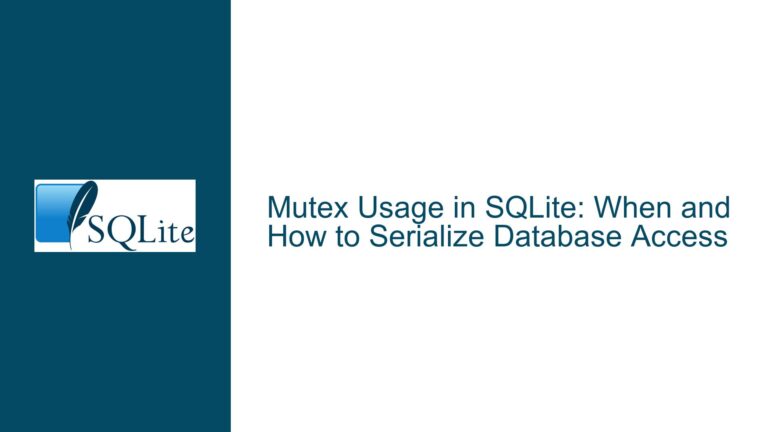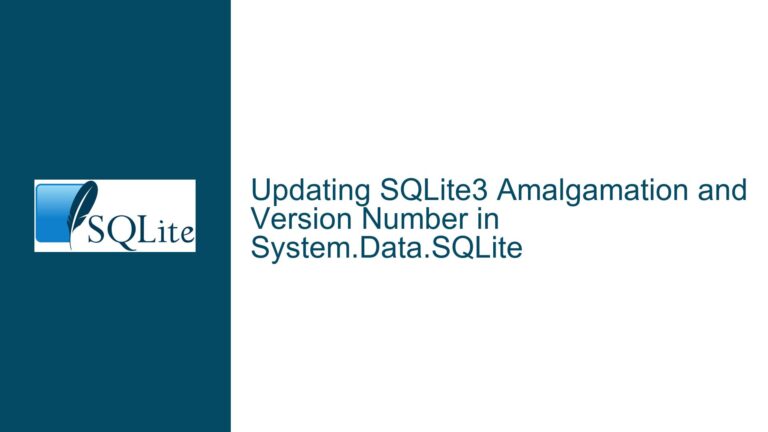Pausing and Reactivating SQLite Triggers: Methods and Considerations
Trigger Control Mechanisms: Conditional Execution vs. Dynamic Lifecycle Management
Understanding the Core Challenge of Temporary Trigger Deactivation
SQLite triggers are automated callback functions that execute specified actions when database events (INSERT, UPDATE, DELETE) occur on designated tables. A common operational requirement involves temporarily suspending trigger execution without permanently removing its definition—such as during bulk data imports, schema migrations, or debugging sessions. SQLite lacks a built-in DISABLE TRIGGER command, necessitating workarounds.
Triggers operate under strict event-driven rules, meaning their activation state directly impacts data integrity and performance. The absence of native pause functionality forces developers to implement indirect control strategies. Two primary approaches emerge from this constraint: conditional execution via WHEN clauses and physical removal/recreation of triggers. Each method carries distinct implications for query performance, transactional consistency, and implementation complexity.
The fundamental challenge lies in balancing overhead costs against operational reliability. Conditional checks introduce per-row computational penalties but preserve trigger definitions. Dropping and recreating triggers eliminates runtime checks but risks definition loss if not properly managed. Understanding the trade-offs between these methods requires deep analysis of their mechanics in real-world scenarios.
Performance Overheads and State Management Risks
1. Conditional Execution via WHEN Clauses
Adding a WHEN clause to a trigger definition allows runtime activation control by evaluating a boolean condition (e.g., checking a debug_mode flag). While this avoids trigger deletion, it imposes unavoidable overhead:
- Per-Row Evaluation: The
WHENcondition is checked for every row affected by the triggering query. For large datasets, this accumulates significant CPU cycles. - State Variable Access: The condition typically references a variable stored in a configuration table, requiring a subquery or join on every trigger invocation.
- Transaction Locking: Frequent updates to the state variable (e.g.,
debug_mode) can cause contention in high-concurrency environments.
2. Trigger Deletion and Recreation
Dropping the trigger with DROP TRIGGER eliminates runtime checks entirely but introduces new risks:
- Definition Loss: Without a backup of the original
CREATE TRIGGERstatement, accidental deletion becomes irreversible. - Transaction Boundaries:
DROP TRIGGERandCREATE TRIGGERare auto-commit operations in SQLite, disrupting atomicity in multi-step transactions. - Concurrency Conflicts: Recreating a trigger while concurrent queries are running may lead to race conditions or incomplete data processing.
3. Hidden Operational Costs
- Schema Versioning: Apps relying on
PRAGMA schema_versionorsqlite_schemachecksums will detect trigger changes as schema modifications, potentially invalidating prepared statements. - Permission Replication: Custom security roles or access controls attached to the original trigger must be reapplied after recreation.
Implementing Robust Trigger Control: Step-by-Step Solutions
Method 1: Conditional Activation with State Variables
Step 1: Create Configuration Table
CREATE TABLE trigger_settings (
trigger_name TEXT PRIMARY KEY,
is_active INTEGER DEFAULT 1
);
Step 2: Define Trigger with WHEN Clause
CREATE TRIGGER audit_update AFTER UPDATE ON employees
WHEN (SELECT is_active FROM trigger_settings WHERE trigger_name = 'audit_update')
BEGIN
INSERT INTO audit_log (action, timestamp) VALUES ('UPDATE', datetime('now'));
END;
Step 3: Toggle Activation State
-- Pause trigger
UPDATE trigger_settings SET is_active = 0 WHERE trigger_name = 'audit_update';
-- Resume trigger
UPDATE trigger_settings SET is_active = 1 WHERE trigger_name = 'audit_update';
Optimization: Add an index on trigger_settings.trigger_name to accelerate the subquery.
Pitfall Avoidance:
- Use
INSERT OR IGNOREto initialize state records for all triggers. - Wrap state updates in transactions if multiple triggers require synchronized activation.
Method 2: Dynamic Trigger Lifecycle Control
Step 1: Backup Trigger Definition
Extract the original SQL from sqlite_schema:
SELECT sql FROM sqlite_schema
WHERE type = 'trigger' AND name = 'audit_update';
Store the result in application code or a helper table.
Step 2: Drop Trigger
DROP TRIGGER audit_update;
Step 3: Recreate Trigger
Execute the stored CREATE TRIGGER statement when reactivation is needed.
Automation Strategy:
- Use a stored procedure to handle backup, deletion, and restoration:
CREATE TEMP TABLE trigger_backup (name TEXT, sql TEXT);
-- Backup and drop
INSERT INTO trigger_backup
SELECT name, sql FROM sqlite_schema WHERE name = 'audit_update';
DROP TRIGGER audit_update;
-- Restore
INSERT INTO sqlite_schema (type, name, tbl_name, sql)
SELECT 'trigger', name, tbl_name, sql FROM trigger_backup;
DROP TABLE trigger_backup;
Pitfall Avoidance:
- Use
ATTACH DATABASEto store backups in a separate file if working with in-memory databases. - Employ advisory locks to prevent concurrent modifications during recreation.
Hybrid Approach: Context-Aware Control
Combine both methods by using WHEN clauses for frequent toggling and DROP/CREATE for long-term deactivation:
CREATE TRIGGER audit_update AFTER UPDATE ON employees
WHEN (
SELECT CASE
WHEN (SELECT use_persistent_flag FROM control_settings) = 1
THEN (SELECT is_active FROM trigger_settings WHERE trigger_name = 'audit_update')
ELSE 1
END
)
BEGIN
-- Trigger logic
END;
This allows runtime selection of the control mechanism via a master configuration parameter (use_persistent_flag).
Transactional Integrity and Concurrency
- Wrap bulk operations requiring trigger suspension in explicit transactions:
BEGIN;
UPDATE trigger_settings SET is_active = 0;
-- Perform bulk data changes
UPDATE trigger_settings SET is_active = 1;
COMMIT;
- Use
WITHOUT ROWIDtables for configuration data to minimize disk I/O during state checks.
Monitoring and Diagnostics
- Track trigger activity via
sqlite3_trace_v2()orEXPLAINto quantify overhead:
EXPLAIN QUERY PLAN
INSERT INTO employees (name) VALUES ('John Doe');
- Analyze the output for trigger-related operations like subquery executions.
Migration and Version Control
- Integrate trigger control logic into schema migration tools (e.g., Flyway, Liquibase).
- Example migration script with conditional activation:
<changeSet id="disable-triggers-for-migration">
<sql>
UPDATE trigger_settings SET is_active = 0;
</sql>
<rollback>
UPDATE trigger_settings SET is_active = 1;
</rollback>
</changeSet>
This guide provides a comprehensive framework for managing SQLite triggers in dynamic environments. By methodically evaluating overhead profiles, state management requirements, and transactional constraints, developers can implement trigger control strategies that align with their application’s performance and reliability goals.






